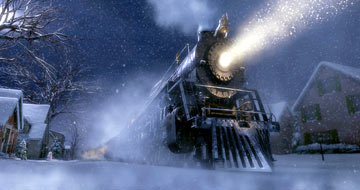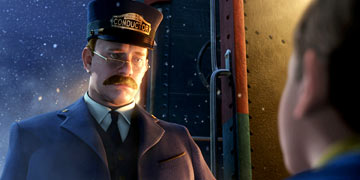

Most films based on books have to deal with trying to take a few hundred pages and condense it into material fit for a movie. The Polar Express has the opposite problem. The classic book by Chris Van Allsburg is only about thirty pages. This meant that director Robert Zemeckis and co-adapter William Broyles, Jr. needed to come up with additional material in order to stretch the book out to feature length. One general rule about screenwriting is that one page of a script is about one minute on screen. Given the book's pages have a minimal amount of text, adapting the story as is yields less than thirty minutes.
Zemeckis (Cast Away, What Lies Beneath) and Broyles (Unfaithful, Planet of the Apes) get the spirit of the book correct. At its core, it is about the joy and wonder of Christmas, and the importance of believing in Santa Claus. It's all the filler material that is the problem. The story within the book is a quiet one. It takes place in the heart of the boy (voiced by Tom Hanks, The Terminal, The Ladykillers) looking to rekindle his love for Christmas. The additional material is loud, brash, and turns a quiet movie into an action adventure. It literally turns the train ride into a 'thrill ride,' with runaway trains, train cars, and dangerous trips over gaping chasms. This does not fit with the spirit of the story, and is in jarring contrast to the rest of the film.
It was probably added to showcase the technology. Zemeckis did a great job getting the look of Van Allsburg's book on screen. The scene where the Polar Express stops in front of the boy's house is wondrous. This isn't technology pushing the cutting edge, it is harnessing technology to get a specific look. But since there was a lot of stuff to add, Zemeckis probably figured some dangerous train ride sequences would look great. To get the characters, the filmmakers used motion capture technology, where Hanks and his co-stars acted with a large number of sensors all over their body. Computers would recreate their motions based on the movement of the sensors. The characters look lifelike, except for one important aspect - their faces. Animating humans is extremely difficult, and typically turns out badly. The people look lifeless and creepy. The Incredibles went the other direction and made the humans cartoon-like. Zemeckis opted for utter realism (a la Final Fantasy) and creates some extremely weird looking people. The hero boy is fine, as is the Conductor (also voiced by Hanks, who did a total of five roles). The hero girl (voiced by Nona Gaye, The Matrix Revolutions, The Matrix Reloaded) looks absolutely frightening.
Thankfully, when the film focuses on the story itself, it works. The hero boy is a doubting Thomas. In order to believe, he needs to see something with his own eyes. The trip to the North Pole is his chance to see that Santa really exists. The North Pole itself looks quaint and warm like something out of Dickens (okay, the warm Dickens). The final scenes with Santa are emotional and moving. It's the rest of the film that needs work. On the ride up, the hero boy keeps getting into trouble, and worse, there is a know-it-all kid (voiced by Eddie Deezen, Spy Hard) who comes across as extremely annoying. Chop out the extraneous material and The Polar Express works as a half hour, possibly forty-five minute special. At one hour forty minutes, it pushes its luck.